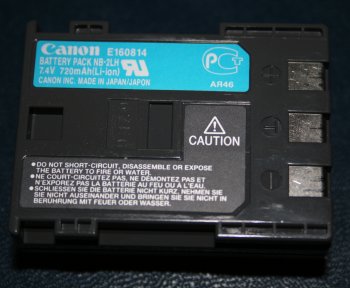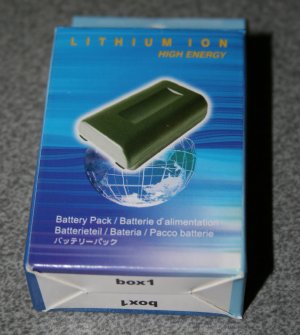The Canon NB-2LH battery is a rechargeable lithium battery used in several of Canon's digital cameras. It claims a capacity of 720 mAh.
Alternative sources of these batteries often claim much higher capacities, but it seems to me that these claims can be exagerated. On this page I show how I have measured the capacity of one of these batteries and found it to be less than the Canon one.
Here are the two batteries that I've compared. First, the original Canon one which came with my camera, marked 720 mAh:

And here is the alternative one, and its box. It is apparently assembled in China from cells made in Japan. I bought two of these on Ebay from a U.S. vendor with lots of satisfied customers. Note that it claims 1200 mAh.


Note that it's not unusual for rechargeable batteries to have significantly differing capacities in the same package. The best-known case is nicad D-cells, which can sometimes contain a cell of only AA dimensions and capacity. These lower-capacity cells are cheaper and this is legitimate as long as the capacity is properly declared.
In the case of D-cells the higher-capacity versions can be quickly identified by their greater weight. My suspicions in this case were first raised when I realised that the original Canon and the alternative battery weighed exactly the same (about 40 g).
So I decided to try to measure the capacity of the two cells. I first charged them using my Canon charger and then discharged them through a 33 Ohm resistor, monitoring the voltage. I used a resistor rated 5 W and it got quite warm. Keeping its leads in contact with the battery terminals was not difficult; I held the battery down and proped the resistor in place with a piece of card. The clips visible in the photo are connected to a voltmeter.

If you are going to try this yourself there is one important thing to remember: the battery may be damaged if you discharge it too much. I decided to stop at 7 volts; it's quite clear by this point that the battery is on its "last legs". You need to keep a close eye on the voltage once it is below about 7.3 V. Of course you're free to discharge it to zero if you don't plan to use the battery again.
Battery chemistry depends on temperature. These experiments were all done at about 23 C ambient.
The voltage shown below is the on-load voltage, which will be below the off-load voltage due to the internal resistance. Here are the results:

It's very clear that the Chinese battery certainly doesn't have a capacity of nearly twice the Canon battery, as it claims. I have computed the following capacities from the data that I collected:
You could get slightly larger numbers by discharging to a lower voltage.
My conclusion is that these batteries advertised as having a capcity of 1200 mAh have no such thing. One explanation is that they are simply fraudulent, but there is a slightly more charitable possibility. These batteries contain two cells, and it could be that the individual cells are rated 3.7 V, 600 mAh. They may have taken these figures and doubled them because there are two cells, but of course it is only the voltage and not the capacity that must be doubled when the cells are connected in series.
I would be most interested to know if anyone has obtained a battery of this sort that definitely has a capacity of around 1200 mAh. My suspicion is that such batteries do not exist.
My advice to anyone looking for cheap batteries of this sort is to assume that any batteries claiming a higher capacity than the manufacturer's original part actually has half the capacity that it claims.